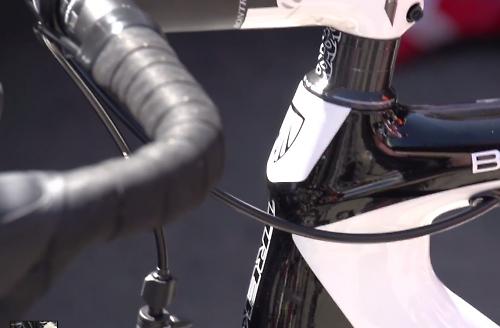- News
- Reviews
- Bikes
- Components
- Bar tape & grips
- Bottom brackets
- Brake & gear cables
- Brake & STI levers
- Brake pads & spares
- Brakes
- Cassettes & freewheels
- Chains
- Chainsets & chainrings
- Derailleurs - front
- Derailleurs - rear
- Forks
- Gear levers & shifters
- Groupsets
- Handlebars & extensions
- Headsets
- Hubs
- Inner tubes
- Pedals
- Quick releases & skewers
- Saddles
- Seatposts
- Stems
- Wheels
- Tyres
- Tubeless valves
- Accessories
- Accessories - misc
- Computer mounts
- Bags
- Bar ends
- Bike bags & cases
- Bottle cages
- Bottles
- Cameras
- Car racks
- Child seats
- Computers
- Glasses
- GPS units
- Helmets
- Lights - front
- Lights - rear
- Lights - sets
- Locks
- Mirrors
- Mudguards
- Racks
- Pumps & CO2 inflators
- Puncture kits
- Reflectives
- Smart watches
- Stands and racks
- Trailers
- Clothing
- Health, fitness and nutrition
- Tools and workshop
- Miscellaneous
- Buyers Guides
- Features
- Forum
- Recommends
- Podcast
TECH NEWS
Video: SRAM electronic groupset is WIRELESS
SRAM may not have been very good (intentionally or otherwise) at keeping their long awaited electronic groupset secret, but they have been better at keeping the fact that it is wireless under wraps - until now.
Earlier this week we got our first real look at the groupset via a CGN video. Now those decoy wires (c’mon SRAM it’s only a groupset) have come off and GCN have got a lot closer still, talking to riders on the Bissell Development team who have been using the new groupset for some time it would appear.
So what do we learn?
It’s not Double Tap . You press once on one shifter to change up at the back, once on the other to change down and both at the same time to shift at the front. As has been pointed out you can already program Shimano Di2 to do this. Double Tap would have been really hard to program and operate in an electronic system and has always had at least as many detractors as fans.
There is no battery unit so the batteries for the front and rear shifters are in the motors. The levers must also contain batteries to power the wireless transmitters.

Look ma, no wires. Only a brake cble connects the front and rear of the Bissell team bike,
It’s robust and reliable, say the Bissell riders. Well, they would. It will have to be, though: SRAM can’t afford any more recall disasters. However, it bears repeating that their disc brake woes stem not from poor design, but a failure of quality control, and that’s something that only shows up in production.
“it’s more aero,” says Tao Geoghan Hart . Marginal gains and all that. There must be some advantage, but given that so many bikes have internally routed cables only a wind tunnel could tell us how much.

What's under the tape on the brake lever? GCN suspects an embossed 'Red' logo.
The Ant+ or Bluetooth (or both) wireless system used gives exciting possibilities for a head unit to give you lots more information about what your bike is doing . Or at least what its gears are doing.
It could be lighter than the equivalent Shimano or Campagnolo. The jury is out on this one as the size of the motors plus batteries on the front and rear deraileurs doesn’t suggest lightness. Looks can be deceiving though, and SRAM have done away with all of those heavy cables. Our guess is that is it lighter than competitor systems, but not by much.
So what are the advantages of a wireless electronic groupset over a wired one?
Well, it looks cooler.
It’s marginally more aero.
It should be marginally lighter.
SRAM could (in theory) incorporate a hydraulic brake master cylinder without the aesthetic implications that affect the current SRAM 22 hydraulic levers.
Did we mention it looks cooler?
Erm…
And the disadvantages?
We don’t know yet. So long as the system is reliable, robust and weatherproof it’s hard to think of any.
The big worry for users will probably be that the signal from the levers to the mechs could be disrupted, but unlike say, a GPS, this is a system in which the constituent parts only need to talk to each other when you want to make them do something: change gear. So even if the system did suffer from interference or disruption to affect performance it would have to happen at the same time you were trying to change gear.

The front derailleur has a hole where the previous decoy wires went in. Could it be a charge port?
On the other hand sceptics will point out that an ethernet cable generally gives a faster and more reliable connection than wi-fi. You don't need to operate your gears from your front room when your bike is in the hall so if you're going to use electronic gears why step away from the tried and true? That will probably be the biggest sales challenge for SRAM when it comes to selling the groupset after market.
What the point of the decoy wires was and why they’ve now come off (maybe they fell off?) only SRAM’s marketing department and the Bissell Development team can truly tell us. That world’s bike media has written about SRAM electronic twice in a week rather than once probably tells us all we need to know.

It's easy to imagine the battery being inside that black housing. Perhaps you flip up the latch and pull it off for recharging.
That SRAM have opted for a wireless set up should be no surprise: many in the industry have predicted that is exactly what they would do. Indeed there would be very little point in them going down the electronic route if the final offering was going to be a late-to-the-party product that offered no more than Shimano Di2 or Campagnolo EPS. Earlier this week James Huang, BikeRadar’s technical editor in the US produced a masterful piece of work on the new groupset, seeing through all those decoy wires, and explaining why SRAM electronic had to be wireless. He even had patent drawings to hand.
One of the other clinchers for Huang that the new groupset was wireless was that SRAM have plenty of form when it comes to choreographing a big launch with ‘leaks’, staged spy shots, and even dummied up prototypes. He might also have mentioned (but didn't) that an in-depth James Huang exclusive is often one of the final moves in SRAM’s elaborate launch rituals.
Unknowns
What the likely battery life is we don’t know, nor do we know for sure how the batteries will be charged. Will they be easily removable for external charging or are those holes in the mech bodies in fact charge points?
When are you likely to see SRAM wireless in your local bikes hop? Bissell’s Geoghan Hart reckons it’s a year away; all the kerfuffle of the past few days suggests it could be here some time sooner.
If it’s spotted on a WorldTour bike in the near future then we’ll expect to see it at Eurobike this year; if not, then Geoghan Hart may be right. However, the clock is ticking under article 1.3.007 of the UCI technical regulations which says that prototype equipment can only be used if it is going to be available to buy within nine months of its first use in a race.
Patent pending
So we've been having a trawl of the US patent office website this morning, and turned up SRAM's pending patent for "electronic shifting systems and methods" filed on 12 December 2012. It's clear SRAM have been working on this a long time and they've done well to keep it under wraps until now.
.jpg)
Here's the summary of the patent: "The invention provides a wireless control system for a bicycle, including at least one shift actuator generating an input signal when actuated and a master control unit transmitting a shift signal responsive to the input signal. At least one electromechanical gear changer is provided and includes a gear changer control unit. The gear changer control unit receives the shift signal from the master control unit and controls at least one electromechanical gear changer corresponding to the received shift signal. The gear changer control unit listens for the shift signal during a part of an awake mode cycle time, the master control unit transmitting the shift signal for a message duration time which is greater than the awake mode cycle time."
Regarding battery life, it appears the system will conserve power by "turning the transmitter and receiver off when not in use and by power cycling the transmitter and receiver when the bicycle is active" with the addition of a 'wake sensor' which puts the system into a sleep mode when not being used.
.jpg)
As for the wireless protocol, the patent indicates a " 2.4 GHz transceiver utilising AES encryption and DSS spread spectrum technology supporting 16 channels and the IEEE 802.15.4 communication protocol."
Interestingly, it looks like the groupset will be able to communicate with devices like a smart phone or cycling computer. "It is also possible for the present system 22 to communicate with other third party devices using standard protocols such as ANT or Bluetooth Smart (BTLE)."
road.cc's founder and first editor, nowadays to be found riding a spreadsheet. Tony's journey in cycling media started in 1997 as production editor and then deputy editor of Total Bike, acting editor of Total Mountain Bike and then seven years as editor of Cycling Plus. He launched his first cycling website - the Cycling Plus Forum at the turn of the century. In 2006 he left C+ to head up the launch team for Bike Radar which he edited until 2008, when he co-launched the multi-award winning road.cc - finally handing on the reins in 2021 to Jack Sexty. His favourite ride is his ‘commute’ - which he does most days inc weekends and he’s been cycle-commuting since 1994. His favourite bikes are titanium and have disc brakes, though he'd like to own a carbon bike one day.
Latest Comments
- Sredlums 5 min 24 sec ago
'Cancel culture' is just a term made up by people who don't like it when actions (or words) have consequences.
- lesterama 8 min 28 sec ago
I guess Nige never had the pleasure of trying our cycling 'infrastructure'. There's a cycle route along the A21, where it bypasses Farnborough,...
- mdavidford 12 min 51 sec ago
You'd hope that a fair amount of that £2m would be upfront costs, though, rather than ongoing....
- ktache 35 min 59 sec ago
Multiple police vehicle involved in crash https://www.theguardian.com/uk-news/2025/apr/09/five-people-in-hospital-... TPAC gone awry?
- mdavidford 59 min 48 sec ago
Begging denied. It's nonsense.
- OnYerBike 2 hours 43 min ago
As far as I can tell, the only story that raised suspicions of a new Bolt was CyclingNews' article, which was published last week - hardly "ages"...
- hawkinspeter 3 hours 45 min ago
None shall be weary nor stumble among them; none shall slumber nor sleep; neither shall the girdle of their loins be loosed, nor the latchet of...
- Rendel Harris 6 hours 3 min ago
That wouldn't be new, more than twenty years ago my insurers tried to avoid paying out on the theft of my motorcycle on the grounds that I couldn't...
- hawkinspeter 22 hours 2 min ago
PKD foresaw it, though his novel was based on a different outcome of WWII, not the precursor to WWIII. Maybe the Idiocracy film is a closer fit?







Add new comment
64 comments
I'm pretty sure 90% of cycling commentary sites knew this was wireless after last weeks convenient reveal.
I'm not going to be buying this bits fall off
The batteries must be removable surely, otherwise you would have to wire up the front, rear derailleurs and shifters when charging, wires wires everywhere ! but taking the battery out the shifters sounds painful.
I really don't see the point of wireless to be honest, aero gains from missing a small piece of 2mm wire... come on ! sounds to me like technology for technology sake.
Wireless? It must be an absolute doodle to setup, clamp on and you are good to go. I reckon you then use your phone to setup and calibrate via bluetooth. There's also some weight gain to be had as well. Plus no battery to mount on the frame. Oh and it'll go on any frame, no internal or external mounts to worry about.
Oh, how about this. The rider in a race goes back to team car during race, 'hey it's not shifting perfectly'. 'No problem, let me adjust.' Mechanic selects the bike on his phone via bluetooth, adjusts and off goes the rider.
Pages